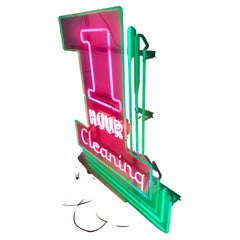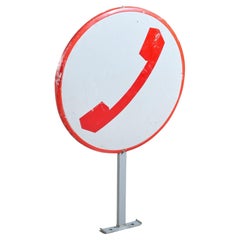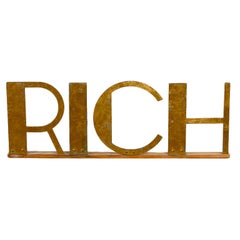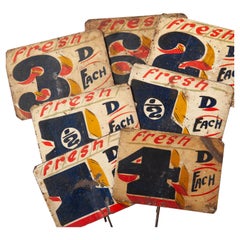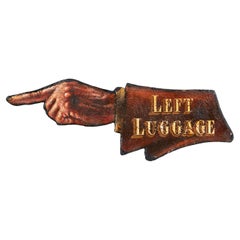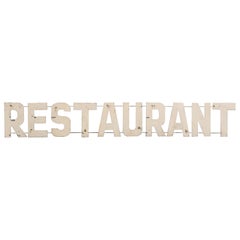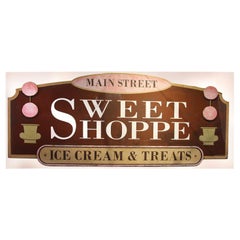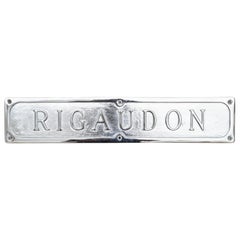Used Signs
11,817
to
55,004
405,527
269,468
416,978
229,717
160,414
158,640
98,968
60,185
52,927
47,641
45,932
38,974
35,898
30,620
24,145
20,388
17,199
13,251
11,354
8,190
6,919
6,550
5,569
4,980
4,170
3,734
3,351
2,353
1,826
1,333
1,239
1,012
953
798
798
600
529
437
361
341
336
323
306
251
246
231
191
134
118
115
78
76
68
58
55
40
36
32
31
28
26
15
7
6
14,412
11,592
7,833
5,862
5,240
Sort By
Amazing 1940s-50s Neon Sign "1 Hour Cleaners" Modernist / Art Deco
By American Neon Sign Co. 1
Located in Buffalo, NY
Wonderful vintage neon sign "ONE HOUR cleaner's"" Salvaged from old dry cleaners in downtown
Category
1950s American Mid-Century Modern Used Signs
Materials
Metal
Telephone Sign
Located in Chicago, IL
Telephone sign.
Category
1970s Italian Used Signs
Materials
Metal
RICH Sign
Located in Darnestown, MD
This seemingly straightforward sign is open to several interpretations. Is it a statement of
Category
1930s American Used Signs
Tole Grocers Signs
Located in Arundel, GB
7 Tole Painted Grocers Signs.
England, circa 1900.
Overall height including pins 15cm.
Category
Early 1900s English Used Signs
Materials
Metal
Action Sports Sign
Located in Chicago, IL
Wrought iron ACTION SPORTS sign.
Category
1960s French Used Signs
Materials
Wrought Iron
Folk Art Sign
Located in London, GB
An Edwardian Folk Art sign with overscale finger, insribed ‘Left Luggage’.
Category
20th Century English Used Signs
Materials
Hardwood
Metal Restaurant Sign
Located in Chicago, IL
Metal restaurant sign from a restaurant in Buenos Aires. Nice size and paint.
Category
1950s Argentine Used Signs
Materials
Metal, Tin
Large Vintage Sign
Located in Sag Harbor, NY
Large one of a kind wooden sign with fantastic details. Great colors and intricate shapes
Category
Mid-20th Century American Used Signs
Materials
Wood
French Sign "Rigaudon"
Located in West Palm Beach, FL
Rigaudon plated sign which means lively dance. Comes from the French, 17th century Baroque folk
Category
20th Century French Used Signs
Porcelain Handicapped Sign
Located in Los Angeles, CA
Vintage porcelain handicapped sign. Great colors. Newly framed and floating in a shadow box. Great
Category
1950s American Used Signs
Materials
Porcelain
1920s Belgian Jenever Sign
Located in Antwerp, BE
1920s Belgian Jenever Sign.
Antique sign - Art Deco sign for Jenever Made in Belgium:
J
Category
Early 20th Century Belgian Art Deco Used Signs
Materials
Tin
1960s Myers's Rum Sign
Located in Antwerp, BE
1960s vintage advertising sign for Myers Rum Jamaica.
Smiling very handsome man with blue eyes, hat
Category
Mid-20th Century Belgian Mid-Century Modern Used Signs
Materials
Other
Beer Sign, Germany, 1940s
Located in Antwerp, BE
Tin advertising sign for German Beer .
This Thuringia beer sign for Vitaminator Nährbier
was made
Category
Mid-20th Century German Art Deco Used Signs
Materials
Tin
Original Cafe Bistro Sign
Located in Chicago, IL
Original Cafe Bistro sign. Fantastic looking with incredible paint and patina. Great condition.
Category
1920s French Used Signs
Materials
Iron
Wall Mounted Telephone Sign
Located in Chicago, IL
Wall mounted telephone sign on an iron bracket. Old school and very fun!
Category
1960s Italian Used Signs
Materials
Metal
Vintage Framed Signed Art
Located in Seattle, WA
Vintage framed signed art
Dimensions. 72 W ; 36 1/4 H ; 3 D.
Category
1970s Mid-Century Modern Used Signs
Materials
Wood, Glass
Vintage Porcelain Beer Sign
Located in Antwerp, BE
is in used condition so does have some traces by age.
It's a great beer sign - beer collectable
Category
Mid-20th Century Belgian Used Signs
Materials
Metal
1960s California Prison Sign
Located in Los Angeles, CA
Unique California state prison sign that reads "KEEP OUT CALIFORNIA STATE PROPERTY". Yellow
Category
1960s American Used Signs
Materials
Steel
Boucherie Chevaline Trade Sign
Located in London, GB
Boucherie Chevaline Trade Sign
A hand crafted Boucherie Chevaline, zinc gold leaf hand beaten
Category
Early 20th Century French Victorian Used Signs
Materials
Zinc
Vintage Neighborhood Watch Sign
Located in Los Angeles, CA
Vintage neighborhood watch sign. Much larger than the standard sized sign. Great muted coloring and
Category
1990s American Used Signs
Materials
Steel
English Pub Sign, Squirrel
Located in Austin, TX
An authentic English pub sign (one-sided) featuring a painting of a squirrel with a nut, untitled
Category
20th Century English Used Signs
Materials
Wood, Paint
French 1950s Enamel Sign
Located in Brecht, BE
These enamel signs were used nearby schools, great decorative object, collector’s item.
Category
Mid-20th Century French Used Signs
Materials
Enamel
'Enter Here' Vintage Sign
Located in Los Angeles, CA
Vintage metal street sign illustrating 'Enter Here.' Sign is affixed to a pipe with reflective tape
Category
1970s American Used Signs
Materials
Steel
Vintage 'Lodging" Highway Sign
Located in Los Angeles, CA
Cool vintage highway sign in cobalt blue reflective metal. Depicts a person sleeping in bed. Sign
Category
1960s American Used Signs
Materials
Steel
Vintage Prison Road Sign
Located in Los Angeles, CA
Cool vintage metal road sign for a United States Prison. Sign is letting the car know that they are
Category
1950s American Used Signs
Materials
Steel
Vintage Steel Engineering Sign
Located in Sagaponack, NY
A graphic rectangular patinated steel wall sign from a venerable Detroit, Michigan engineering firm.
Category
Early 20th Century American Industrial Used Signs
Materials
Iron
Vintage 'Phone' Highway Sign
Located in Los Angeles, CA
Cool vintage highway sign in cobalt blue reflective metal. Depicts a large white phone on a blue
Category
1970s American Used Signs
Materials
Steel
French Metal Coiffeur Sign
Located in Seattle, WA
Simple, interesting French hairdressing sign.
Category
1940s French Used Signs
Materials
Metal
Vintage "NEW" Road Sign
Located in Los Angeles, CA
Interesting vintage road sign made of steel. Depicts the word "NEW" at the bottom with an orange
Category
1970s American Used Signs
Materials
Steel
Hollywood Sign Artist Model
Located in Los Angeles, CA
Fun piece of Los Angeles artwork. Hollywood sign made as an artist's model to make larger versions
Category
Early 2000s American Used Signs
Materials
Metal
Rare Glass Pedestrian Sign
Located in Los Angeles, CA
Fantastic glass pedestrian street crossing sign. Great coloring. Excellent condition. Illuminates
Category
1950s American Used Signs
Vintage DRUGS Street Sign
Located in Los Angeles, CA
Vintage DRUGS street sign with white background and black lettering. Interesting piece of
Category
1970s American Used Signs
Materials
Steel
Antique Clock Advertising Sign
Located in West Palm Beach, FL
Antique hand-painted advertising sign in the shape of a large pocket watch showing the name BB
Category
19th Century Used Signs
Vintage European Street Sign
Located in Los Angeles, CA
Great vintage European street sign. Deep blue and white. Newly mounted and framed. People at play
Category
1970s Italian Used Signs
Materials
Steel
Cowboy Boot Advertising Sign
Located in Palm Springs, CA
Monumental and heavy painted steel advertising sign in the shape of a cowboy boot. Boot was most
Category
1940s American Used Signs
Materials
Steel
Vintage Neon "YOU" Sign
Located in Los Angeles, CA
Vintage neon sign, spelling Y - O - U. handcut metal channel letters with hand bent neon glass
Category
1980s American Used Signs
Materials
Metal
18th Century Apothecary Sign
Located in Napa, CA
18th Century Apothecary sign was created with wrought iron, fer forge. Beautiful details of the
Category
18th Century and Earlier Italian Used Signs
Materials
Wrought Iron
Double Sided Sign circa 1950
Located in Culver City, CA
Double Sided Sign
England circa 1950
Hand painted sign with ebonised frame.
25.5”w x 1.75”d x 16.5
Category
1950s English Modern Used Signs
Materials
Wood
Gazelle Bicycles Glass Advertising Sign
Located in Antwerp, BE
Old glass advertising sign for Gazelle Bicycles, a bicycle factory in the Netherlands since 1892
Category
Mid-20th Century Dutch Art Deco Used Signs
Materials
Glass
Large Red Liebig Sign, 1950s
Located in Antwerp, BE
Large Red Liebig Sign from the 1950s.
A French porcelain sign - enameled metal sign for Liebig
Category
Mid-20th Century French Modern Used Signs
Materials
Metal
English Pub Sign, "Nag's Head"
Located in Austin, TX
An authentic English pub sign (two-sided) featuring a painting of a horse's head in a bridle
Category
20th Century English Used Signs
Materials
Metal
English Pub Sign, "The Ship"
Located in Austin, TX
An authentic English pub sign (one-sided) featuring a painting of a British brigantine or two-mast
Category
20th Century English Used Signs
Materials
Metal
Enamel Sign for Colman’s Mustard
Located in Cheshire, GB
Enamel sign for Colman’s Mustard, of rectangular form decorated in blue and yellow enamel
Category
Early 20th Century British Used Signs
Materials
Enamel
Enamel Sign for Colman’s Starch
Located in Cheshire, GB
Enamel sign for Colman’s Starch, of rectangular form decorated in blue and white enamel
Category
Early 20th Century British Used Signs
Materials
Enamel
English Pub Sign, "The Admiral"
Located in Austin, TX
An authentic English pub sign (one-sided) featuring a portrait painting of a decorated Royal Navy
Category
20th Century English Used Signs
Materials
Metal
English Pub Sign, "Fountain Head"
Located in Austin, TX
An authentic English pub sign (one-sided) featuring a painting of a Classical urn or fountainhead
Category
20th Century English Used Signs
Materials
Metal
Vintage Reflective Bicycle Road Sign
Located in Burton, TX
This Vintage Reflective Road Sign depicts a black bicycle with a yellow background. Once used as a
Category
Late 20th Century American Used Signs
Materials
Metal
Vintage Reflective Truck Road Sign
Located in Burton, TX
This Vintage Reflective Road Sign depicts a black truck with a yellow background. Once used as a
Category
Late 20th Century American Used Signs
Materials
Metal
Exceptional Vertical Enamel Cafe Sign
Located in Chicago, IL
Enamel cafe sign with light sockets and a new mounting bracket.
Category
Early 1900s American Used Signs
Materials
Enamel, Iron
Early Timber & Iron Railway Sign
Located in Downham Market, GB
An early vintage railway notice sign.
A wonderful, early & exceptionally original timber platform
Category
20th Century British Sporting Art Used Signs
Materials
Enamel
1930s Sign for Bicycle Parts
Located in Antwerp, BE
1930s Sign for bicycle parts.
An Art Deco sign dated 1937.
Black advertising sign with soft
Category
Mid-20th Century Belgian Art Deco Used Signs
Materials
Metal
French Hand-forged Blacksmith Sign
Located in London, England
Beautifully crafted blacksmith trade sign.
Hand-forged and riveted, not welded.
A seriously
Category
1950s French Folk Art Used Signs
Materials
Iron
English Pub Sign, "Nag's Head"
Located in Austin, TX
An authentic English pub sign (one-sided) featuring a painting of a horse's head in a bridle
Category
20th Century English Used Signs
Materials
Metal
Elizabeth Arden Vintage Wooden Signs
Located in Milano, IT
Rare advertising sign of Elizabeth Arden, an entrepreneur who founded, in that name, her cosmetics
Category
1950s Italian Mid-Century Modern Used Signs
Materials
Aluminum
20th Century, Original Painted Sign
Located in Los Angeles, CA
This original painted black and white trade sign reads Reserved for district. This cool one sided
Category
20th Century American Country Used Signs
Materials
Wood
Large 19th Century Wooden Painted Lounge Sign This Is an Original Hotel Sign
Located in Chillerton, Isle of Wight
A Large 19th century Wooden Painted LOUNGE Sign
This is an original Hotel sign it is made in
Category
Early 1900s Art Deco Used Signs
Materials
Pine
H 15 in W 73 in D 1.5 in
1950’s Neon Sign Diner
Located in Chicago, IL
1950’s neon sign Diner. It has new transformer and new wiring. Please note that this sign needs to
Category
1950s American Mid-Century Modern Used Signs
Materials
Metal
1970's ice cream sign
Located in Brecht, BE
Vibrant colors for this 1970's ice cream sign, found in the South of Spain
Category
Mid-20th Century Spanish Used Signs
Materials
Polyester
19th Century, Apothecary Trade Sign
Located in Nantucket, MA
Figural trade sign in the form of a mortar and pestle, both the mortar and pestle are hand turned
Category
Late 19th Century North American Folk Art Used Signs
Materials
Zinc
Vintage 'No Bikes' Street Sign
Located in Los Angeles, CA
Vintage 'no bikes on sidewalk' sign with incredible sunburn weathering patina. Steel sign featuring
Category
1970s American Used Signs
Materials
Steel
- 1
- ...
Get Updated with New Arrivals
Save "Used Signs", and we’ll notify you when there are new listings in this category.
Used Signs For Sale on 1stDibs
An assortment of used signs is available at 1stDibs. Each of these unique used signs was constructed with extraordinary care, often using metal, wood and glass. Used signs have been made for many years, and versions that date back to the 18th Century alongside those produced as recently as the 21st Century. Used signs made by Folk Art designers — as well as those associated with Industrial — are very popular at 1stDibs. There have been many well-made used signs over the years, but those made by Coca Cola Bottling Co., Gods Own Junkyard and Fred G. Johnson are often thought to be among the most beautiful.
How Much are Used Signs?
Prices for used signs start at $55 and top out at $80,000 with the average selling for $1,450.
Questions About Used Signs
- 1stDibs ExpertApril 5, 2022The font used on London street signs is usually Univers Bold Condensed. However, local councils have the freedom to choose their own fonts, so you may see variations from the usual typeface in some places. You'll find a large collection of typographic art on 1stDibs.
More Ways To Browse
E Fisher
Tin Litho
Antique Zinc Horse Head
Eastern Bloc
Retro Gas Station Signs
Nyc New York Porcelain
Wrought Iron Vintage Wall Art
Vintage Signage
Vintage Crackers
Felt Pennant
Butcher Shop Head
Solingen Vintage
Oak Street Vintage
Retro Pilot Glasses
Antique Native American Arrow
Antique Advertising Bicycles
Lady And Tramp
Lady And The Tramp
